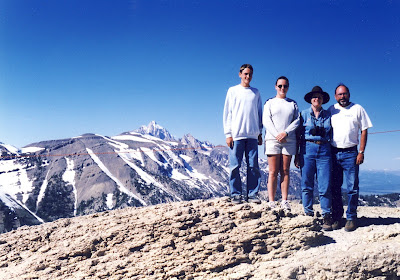Wednesday, July 8th we took a three day, two night exploration into southwest Montana.
Butte, Montana
We arrived in Butte for an early lunch at the Uptown Café and then spent the afternoon touring Butte. Our first stop was the Berkeley Pit, a copper mine in operation from 1955 to 1982. The Berkeley Pit is 1700 feet deep and nearly three miles around the outside. When it closed it was the largest open pit copper mine in the United States. When the mine shut down in 1982, the underground pumps were shut off and the Pit has slowly filled with acidic water.
.
 |
| The Berkeley Pit |
The Lexington Stamp Mill was Butte's first stamp mill, built in 1867. A stamp mill is an ore crushing machine that pounds rock into fine sand in order to extract the minerals from the ore. So much copper was removed from this seven square mile hill that you could make a 4 lane highway from Butte to Salt Lake City paved with copper 4 inches thick. This was called "the richest hill on earth."
 |
The last remaining stamp mill is now
preserved and surrounded
by the Lexington Botanical Gardens. |
The Granite Mountain Memorial is dedicated to the 168 men who lost their lives in hard rock mining's greatest disaster on June 8, 1917.
 |
| The Granite Mountain Memorial sits high above overlooking Butte. |
Dotting the landscape of the Butte Hill are 14 tall, black, steel structures referred to as "gallows frames" or headframes. These mark the remnants of entrances to the mines that honey-comb the Butte Hill. Cables from a hoist house passed over sheave wheels at the top of the frame, lowering miners to their work, transporting mules, equipment and supplies down the shaft and bringing up ore.
 |
A Red Tour Trolley passes a Headframe as it ascends
the hill north of Butte.
Haze in the valley from distant forest fires. |
We spent our first night at the Fairmont Hot Springs Resort 15 miles northwest of Butte. There are a total of four very large pools with temperatures between 88° and 104°, two outside and two inside. These pools are open year round and as a guest you can use them 24 hours a day.
 |
| There is a 350', four story waterslide. |
Deer Lodge, Montana
The Powell County Museum Complex includes the Prison Museum, The Montana Auto Museum, Yesterday Playthings Museum, Frontier Museum and even a couple more. One ticket provides access to all five museums. We started at the Old Prison Museum for a self-guided walking tour. Built in 1870 with inmate labor, this is one of Montana's oldest structures. It was in continuous use for 110 years until a new prison was built just 5 miles away. The Montana Auto Museum was very impressive with over 150 vehicles on display including classic muscle cars, Ford Model A's and T's, V-8 Fords, Chevy Corvettes, Ford Mustangs and a Detroit Electric Car from 1914, REO Speedwagon, and a Porsche 356A.
 |
Montana Territorial Prison
and later a State Prison |
Grant-Kohrs Ranch National Historic Site located on the north end of Deer Lodge is quite an impressive ranch. Settled in the 1860's by Johnny Grant it became the headquarters of cattle baron, Conrad Kohrs. This site is preserved as a working cattle ranch by the National Park Service.
 |
We were just in time for a house tour as well
as a self-guided tour of the grounds. |
Philipsburg, Montana
Our second night we stayed in Philipsburg at the historic Broadway Hotel. Built in 1890, this newly renovated 9 room hotel is more like a bed and breakfast. The rooms were cozy and very nicely made up. We stayed in the "Hard Rock" Room which was decorated in mining décor, including metal hard hats, rocks and a pick ax on the headboard. We took a walking tour of the town with over 50 historic buildings to see. This town, located near what was once know as the largest silver mine on earth, won the designation as one of the "Prettiest Painted Places in America."
 |
First floor is a hardware store with the
Broadway Hotel on the second floor. |
 |
The Sweet Palace
with fresh candy made daily. |
 |
The candy store was even more popular
than the micro-brewery. |
Anaconda, Montana
As we completed the 64 mile Pintler Veteran's' Memorial Scenic Highway, we passed through the town of Anaconda.
 |
| Deer Lodge County Courthouse |
 |
| 585 Foot tall smelter stack remains as a silent monument |
Big Hole National Battlefield, Montana
This battlefield memorializes the 1877 clash between five bands of Nez Perce Indians, numbering 800 and the 7th U.S. Infantry soldiers and volunteers. We watched a 26 minute movie in the brand new visitor center, looked through the museum, enjoyed a picnic lunch and took a short walk to the battlefield and monument.
Salmon, Idaho
Returning to Idaho, we stopped again at our favorite restaurant in Salmon, Bertram's Brewery and Restaurant, for their Friday Prime Rib special, before returning to our base at Camas.














































